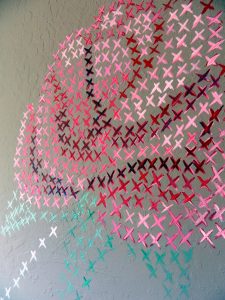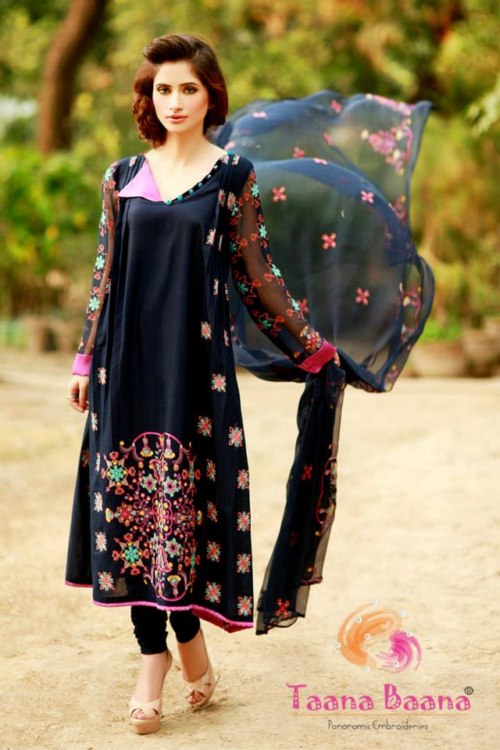Cross stitch is one of the oldest forms of embroidery found in the world today. It is done by making small x shaped stitches to form a picture or pattern. This technique has been passed down from generation to generation, and that is why nearly every cultural museum around the world has some piece of cross stitched cloth on display.
History
Cross stitch is thought to have been used in the prehistoric times, as cavemen used this particular stitch to sew together dried animal skins to be used as clothes. While the earliest examples of cross stitched items have been found in the tombs of Egypt, in the 7th century AD. Interestingly, it is thought that under the Islamic society of the Moors (756-1492), Blackwork (embroidery in form of geometric shapes, done on white linen with wool from black sheep) was the method which developed cross-stitch in Spain. Furthermore it is assumed that this method traveled to Britain when the Spanish Catherine Aragon married King Henry VIII.
During the 16th century it gained popularity in Europe and the USA. It was done by both women and young girls, and as they were not allowed formal education, it was one way of learning alphabets, counting and shapes. Each embroiderer made a ‘sampler’, which was a long strip of cloth that contained samples of stitches and designs. Later, during the 17th century it began to thrive in Germany, Holland, Britain and the USA, and thus needlework skills were taught at school because cross-stitch was used for household beautification by adorning table-clothes, runners, place-mats, handkerchiefs, cushion covers, bedspreads etc. It was even taught at some orphanages; as it would be beneficial for those girls who would later on look up jobs as domestic help.
By the 18th century, people were creating beautiful wall-hangings that included buildings, sceneries, and figures that provide us with an insight to the social settings of that time.
During the 20th century, associations, academies, schools, communities, and publications across the world were established, and they are the reason why cross stitch has evolved into what it is today. It is also done for charitable purposes.
Patterns in Cross stitch
There are two types of patterns used in cross stitch. In Counted-thread, the pattern is printed on paper in the form of a graph, where there are different symbols in the boxes to represent the number of stitches to be made using a specific color. In Stamped, the pattern has to be printed on the textile, and it is color coded so that you know where to use which color.
Fabrics & Threads Used
Aida fabric is the most widely used. It a basket-weave fabric and comes in an assortment of colors. It is now also available in hand dyed and printed variety. Waste Canvas is similar to Aida, but it is used to create patterns for those fabrics on which cross stitching is not directly possible such as t-shirts, dresses and jeans. Plastic Canvas is used to make lovely cross-stitched gift boxes of any size. There is a specific thread used, which is made from mercerized cotton also known as pearl because of its shiny appearance. Moreover double thread is required to do embroidery in most designs. The oldest manufactures are DMC and Anchor and have been producing since the 1800s.
Cross Stitch in Pakistan
 Every region in Pakistan is eminent because of its specific type of embroidery. However cross-stitch is rather generic, as it is done in various areas. It was perhaps in the late 1960s, that cross-stitch was seen as a prospective commercial venture. For this purpose poor women from rural areas of Multan, Bahawalpur, Choti, Dera Ismail Khan and Larkana were employed to do cross stitch on kameez and dupattas that were later sold by a responsible person, who usually visited people at their residences personally. These women do remarkable work, as they cross stitch on fabrics such as cotton, lawn, silk and chiffon, which is very difficult because there is no grid like that on Aida fabric and neither is the pattern printed on the fabric. It is all based on the precision of their hand and eye. They also do not have access to commercial thread. They work with ordinary cotton thread which they wash numerous times, treat with salt and then dry in the sun before using.
Every region in Pakistan is eminent because of its specific type of embroidery. However cross-stitch is rather generic, as it is done in various areas. It was perhaps in the late 1960s, that cross-stitch was seen as a prospective commercial venture. For this purpose poor women from rural areas of Multan, Bahawalpur, Choti, Dera Ismail Khan and Larkana were employed to do cross stitch on kameez and dupattas that were later sold by a responsible person, who usually visited people at their residences personally. These women do remarkable work, as they cross stitch on fabrics such as cotton, lawn, silk and chiffon, which is very difficult because there is no grid like that on Aida fabric and neither is the pattern printed on the fabric. It is all based on the precision of their hand and eye. They also do not have access to commercial thread. They work with ordinary cotton thread which they wash numerous times, treat with salt and then dry in the sun before using.
While women in Hunza valley in the Gilgit Baltistan region are famous for making striking cross-stitched head caps in vibrant colors and floral motifs worn by their older women. Only last year at the Lok Virsa folk festival, a 77 year old craftswoman was honored for keeping cross-stitch alive by teaching it to the younger generation. Also the interior decors of Serena Hotels in Gilgit, Hunza and Islamabad include many stunning cross-stitched pieces done by Hunza women.
The half cross-stitch is one of the four types of stitches used in a swati embroidery technique called The Astari Gandel, which is an example of eye-catching embroidery. The stitch is either sewn backwards (/) or forwards (\). (Cross-stitch can be done in one-fourth and three-fourth stitch as well, adding more intricacy to the pattern)
 Now its been several years since cross stitch has become in-vogue with the establishment of the Cross Stitch Label. It is dedicated specifically to producing unstitched as well as stitched clothing for casual, semi formal, and formal clothes by blending traditional cross- stitch with their contemporary designing. Other well known clothing labels such as Khaadi (www.khaadionline.com) and Taana Baana (www.taanabaana.com.pk) also offer cross-stitch embellished clothing. Furthermore, since machines have become easily available now, small textile mill owners have also had them installed, and cross-stitched suits are found at ordinary cloth shops in many cities, especially Lahore. Certain women entrepreneurs have started this business at their homes as well.
Now its been several years since cross stitch has become in-vogue with the establishment of the Cross Stitch Label. It is dedicated specifically to producing unstitched as well as stitched clothing for casual, semi formal, and formal clothes by blending traditional cross- stitch with their contemporary designing. Other well known clothing labels such as Khaadi (www.khaadionline.com) and Taana Baana (www.taanabaana.com.pk) also offer cross-stitch embellished clothing. Furthermore, since machines have become easily available now, small textile mill owners have also had them installed, and cross-stitched suits are found at ordinary cloth shops in many cities, especially Lahore. Certain women entrepreneurs have started this business at their homes as well.
With the introduction of machines the work of our women artisans has indeed been affected. For this reason, craft bazaars/folk festivals are organized and certain fashion designers have utilized their skills in their own signature items, which are then exhibited and sold around the country. NGO’s that have been working on this purpose, also market their items. One example is Behbud Boutiques, which were probably the first to sell cross-stitched work of poor women who don’t have the resources, and have been doing this for nearly 40 years now. They are located in Rawalpindi, Islamabad, Lahore and Karachi.
So although cross-stitch began its journey centuries ago, it went on to become an important part of our cultural heritage and current fashion scene.
